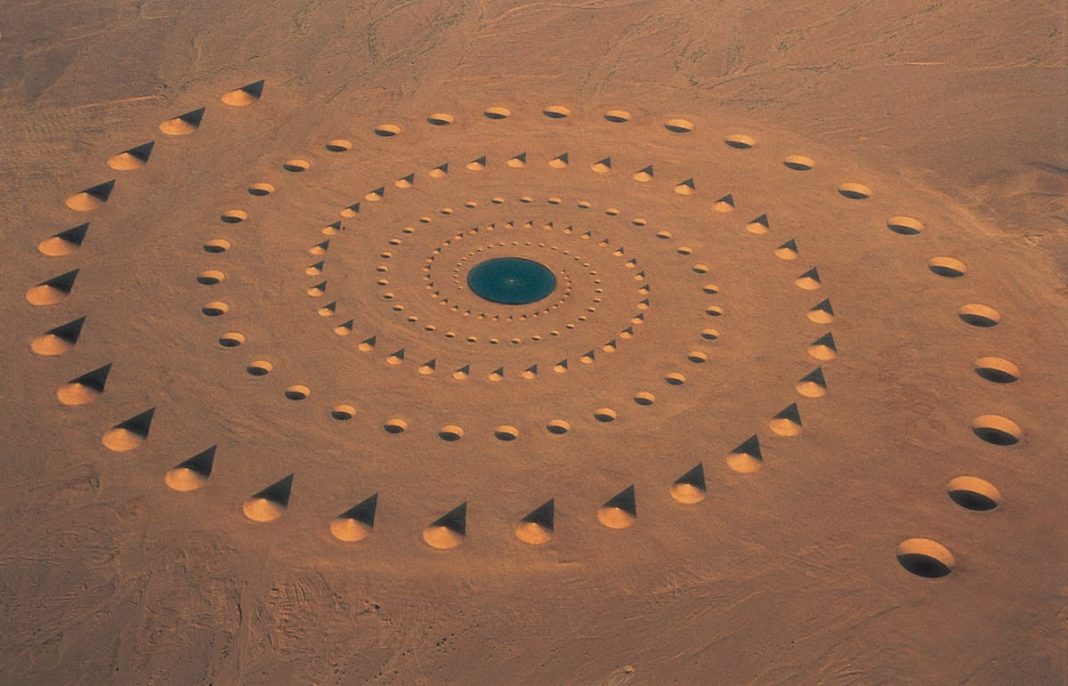In the vastness of our planet, art finds a way to claim even the most secluded spaces, transforming them into realms of exploration and wonder. This journey into the world’s most remote art installations is not just a testament to artists’ boundless imagination but also an invitation to reevaluate our relationship with space, solitude, and the sublime. These installations, set against nature’s grand canvases, challenge the very notion of accessibility and viewership, offering unique experiences for those willing to seek them out.
1. Desert Breath, Egypt
Nestled in the Sahara Desert near the Red Sea, Desert Breath is a colossal land art project that stretches across 100,000 square meters. Created in 1997 by the D.A.ST. Arteam, this installation comprises a series of cones and a gaping central pool, all meticulously arranged to form a double spiral visible from above. Despite the inevitable encroachment of the desert sands over time, Desert Breath remains a hauntingly beautiful meditation on infinity and the impermanence of existence.
2. The Enchanted Highway, USA
Stretching for 32 miles through the rural expanse of North Dakota, The Enchanted Highway is a testament to the transformative power of art. Initiated by local artist Gary Greff in 1990, this open-air gallery features a collection of the world’s largest scrap metal sculptures, including “Geese in Flight” and “The Tin Family.” Greff’s vision to revive his dwindling hometown through art has not only turned a remote highway into a whimsical journey but also into a pilgrimage site for art lovers and road trippers alike.
3. Underwater Sculpture Park, Grenada
Beneath the turquoise waters of the Caribbean Sea lies a hauntingly silent congregation: the Molinere Underwater Sculpture Park. Conceived by Jason deCaires Taylor in 2006, this submerged gallery not only serves as a poignant reflection on human interaction with the natural world but also as an artificial reef promoting coral growth. The figures, ranging from solitary individuals to a circle of linked hands, invite divers to ponder humanity’s place within nature’s embrace.
4. Arctic Circle Light Installation, Norway
In the unforgiving cold of the Arctic Circle, where the sun barely rises or sets depending on the season, stands a remarkable testament to human creativity and resilience. The Arctic Circle Light Installation, a series of light works by various artists, illuminates the polar night with ethereal glows, casting both warmth and wonder into the heart of darkness. This installation not only challenges the limits of where art can thrive but also serves as a beacon of hope in the face of environmental changes.
5. Prada Marfa, USA
On a lonely stretch of highway in the Texas desert lies Prada Marfa, a faux luxury storefront erected in 2005 by artists Elmgreen and Dragset. This surreal installation, complete with high-end shoes and handbags from Prada’s fall collection, critiques consumerism’s absurdity while offering a mirage of luxury in the desolate landscape. Prada Marfa transcends traditional gallery spaces, inviting viewers to reflect on art, commerce, and isolation.
6. Sun Tunnels, USA
Deep in the Great Basin Desert of Utah, Nancy Holt’s Sun Tunnels (1973-1976) frame the cosmos. Comprising four massive concrete cylinders, this land art masterpiece aligns with the sun during solstices, capturing light and shadow in a dynamic play that unfolds throughout the year. Holt’s work is a pilgrimage site for those seeking to connect with the celestial rhythms, offering a profound space for contemplation amid the vastness of the desert.
Conclusion: Art Beyond Boundaries
These installations remind us that art is not confined to the walls of galleries and museums; it is a force that compels us to venture into the unknown. By placing these works in remote locations, artists invite us on a journey that challenges both our physical and perceptual boundaries, offering transformative experiences that linger long after the journey ends. In the quest for these distant creations, we find not just art, but a deeper connection to the planet and ourselves.
As technology and social media continue to shrink our world, these remote art installations stand as bastions of the unexplored, urging us to step away from the screen and into the vast, unmediated wild to discover them. In this exploration, we are reminded that the most profound experiences often lie beyond the edge of comfort and convenience, waiting in the silence of remote corners of the earth.

